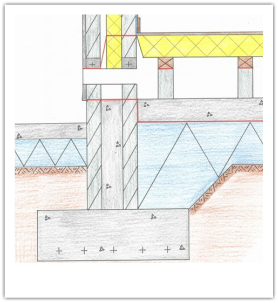
The performance of the building envelope can be considerably impacted by the choice of building materials. In order to maximise solar gain, buildings facing south should have more glazing, whereas those facing north should have less glazing in order to minimise heat loss. The performance of the building envelope can be considerably impacted by the building orientation. For instance, to minimise heat loss, buildings in cold climates should have a well-insulated envelope, and similarly, to prevent heat gain, structures in hot climates should have a well-ventilated envelope. The building envelope needs to be built to resist the region's particular climate. When constructing a building envelope, a number of considerations need to be taken into account, including: H3: Weather: To prevent water penetration, which can seriously harm the construction of the building, it is crucial to make sure the foundation is well-designed and built. The foundation serves as the base of the building envelope, supporting the structure and guarding against moisture seepage from the ground.
#Building envelope components windows
To prevent air leakage, which can drastically lower the building's energy efficiency, it is crucial to make sure that windows and doors are well-designed and built. They are essential in providing security and insulation, as well. Openings in the building envelope such as windows and doors let fresh air and natural light inside. Wood, concrete, and steel are just a few of the materials that may be used to create walls. When it comes to offering structural support, insulation, and defence against the elements, they are essential. The vertical elements of the building envelope that divide the inner and outdoor environments are the walls. It is essential to make sure the roof is properly designed and built to stop water infiltration, which can seriously harm the building's structure. The roof, which is the topmost portion of the building envelope, shields the structure from precipitation, ice, and other weather-related hazards. The building envelope is made up of a number of parts, each serving a particular purpose. In turn, this results in cheaper utility costs and a less carbon footprint. The amount of energy needed to maintain a suitable indoor temperature can be greatly reduced by a well-designed and constructed building envelope. The building envelope function in improving the building's energy efficiency is another crucial factor. Additionally, it stops allergens and pollutants from entering the building, maintaining a healthy indoor atmosphere. It serves as a shield against snow, rain, wind, and other weather elements. The building envelope is essential in shielding the occupants and the structure from the outside elements.


An effective building envelope can greatly improve a building's energy efficiency, indoor environmental quality, and durability. It is made up of a number of parts, including the foundation, walls, windows, and doors. The physical line dividing a structure's inner environment from its surrounding environment is referred to as the building envelope. The significance of the building envelope and its numerous components will be discussed in this article. It is made up of numerous parts that are essential for providing defence against the weather and preserving indoor environmental quality. The physical barrier separating a structure's interior and outside is called the building envelope, sometimes referred to as the building shell.


 0 kommentar(er)
0 kommentar(er)
